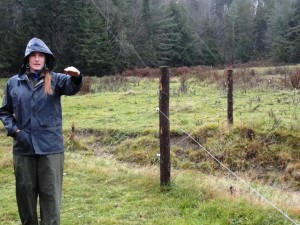
Looking at land that has been underwater.
Our interview continues with Rachel Schattman of the Agroecology and Rural Livelihoods Group about the Vermont Agricultural Resilience to Climate Change Initiative. This post was first published on the Farming & Climate Change Adaptation blog on July 22, 2015. Also see Part 1 here.
Center for Sustainable Agriculture (CSA): Were there any Best Management Practices (BMPs) which were adopted for resilience reasons that didn’t fit into the strategic categories you identified: diversification, water management in the context of soil health, and innovative production?
Rachel: The way we selected the BMPs to highlight was that we looked at what the farmers were practicing and the degree to which these farmers felt that the BMPs protected them from the effects of climate change. We definitely could have added more BMPs; rotational grazing is a great example of a strategic practice that can improve soil health and therefore water management on the farm. Manure injection and riparian buffers qualify as BMPs that have great potential to protect farms from some effects of climate change.
We chose the practices as examples of what farmers in Vermont are doing now, not an inventory. There were a couple of BMPs that stood out as not fitting into one category, but which spanned many: monitoring of farm ecosystems (aka “agroecosystems”), was highlighted as a key approach for increasing resilience. In brief, if we don’t really know what’s going on in farm systems, it’s hard to make the best decisions about how to adjust farming practices. Having monitoring systems that deliver consistently reliable and useful information is critical for improving sustainability.
How to build better relationships between university-based researchers, farmers, municipalities and other public institutions so that the flow of data is used effectively is equally as important as deciding what we need to monitor.
CSA: On occasion, we have heard from farmers that they are optimistic about the effects of climate change, such as a longer growing season. Did you speak to any farmers who felt this way?
Rachel: Sometimes farmers would make off-hand comments to the effect of “a longer growing season isn’t something to complain about!” or “Wouldn’t it be great to grow avocados in Vermont?”
When not speaking in jest, however, several farmers confirm what researchers also know: more frost free days in a growing season is only one piece of the puzzle. Daylight hours, which have a large impact on many kinds of crops, will not change as the climate warms. In addition, increased warm and wet weather could have a negative effect on crops if it is accompanied by an increase in plant pathogens or increased numbers of pest generations.
One farmer who grows crops in a river valley in central Vermont noted that even in late summer seasons where frosts did not kill his crops, he faced an increase in pests and plant disease that undermined any benefit he garnered from the warm weather.
CSA: Did you notice any BMPs that were of particular value specifically for organic farmers? For conventional growers?
Rachel: We interviewed farmers of both organic and conventional operations, but we didn’t notice BMPs that were specific to either group. Often, organic producers distinguish themselves by noting that soil health and the long term sustainability of their operation guides their decision making and therefore their choice of management practices. The group of organic farmers we interviewed for this project echoed this – but so did the conventional growers!
One dairy farmer comes to mind who manages a farm spread between several towns in northern Vermont. He is a fifth generation dairy farmer and is very good at thinking about the long term sustainability of his family’s operation. He is particularly attentive to managing the flow of nutrients and water on his farm and uses practices that minimize manure run off and seepage from stored feed.
The BMPs we identified were not aligned with either organic or conventional farming approaches. Rather, we found the more stark distinction between groups of farmers to be based on the timeframe in which they were planning their management strategies. Farmers who think strategically about the distant future of their farm may be more attracted to some BMPs, while farmers who only plan one to five years ahead may be more attracted to others.
Each BMP varies in terms of the timeframe in which it is effective. For example, if a farmer diversifies their markets today, they have almost immediately realized the benefit of that strategy. If that same farmer plants a riparian buffer along a stream bank, they may see 15 years pass before that buffer is established.
CSA: Effective communication between service providers and farmers requires a lot of work and trust-building; this can be especially true around the topic of climate change. Are there key characteristics of the service providers you interviewed, and the way they communicated that enable them to develop strong relationships with farmers?
Rachel: While we didn’t ask farmers specifically about qualities of effective service providers, we did ask them where they received their most useful and trusted information. We can also make our own list of qualities of service providers based on our anecdotal observations of those we interviewed and our experience with this group.
Farmers reported a few organizations to whom they looked regularly for production advice including:
However, before they mentioned an organization or technical service provider, all of the farmers said that they relied heavily on their peers.
This tells us that practitioners want to learn from practitioners, and that a good service provider is one that can facilitate learning opportunities between peers. We believe that a deeper level of climate change science needs to be shared with farmers, and that providing opportunities for key individuals to keep abreast of new research will benefit wide networks of farmers.
Second, we observed that the technical service providers that could most effectively work with farmers on limiting climate change risk understand climate change on a global level. They take initiative to educate themselves beyond what they hear on the news and can distinguish good quality information from theatrical politics.
Rather, addressing risk in all its forms is their mission and approach, and sharing the excitement about innovative adaptation approaches is part of what makes them invaluable to farmers.
CSA: Thank you for talking with us. Any additional thoughts you’d like to pass along?
Rachel: There is a big elephant in the room, and that is that this project is primarily focused on climate change adaptation, but does not address climate change mitigation. There are some that say that climate change is still too politicized a topic, primarily because of debate over if human activity causes climate change or not. In our study, we found that most people believe that climate change is real, and many believe that human activity is a significant driver. This last point is the most contentious in the United States, as anyone who listens to the news or follows politics knows.
Furthermore, we contend that in order to be resilient in the long run, we all have to acknowledge humanity’s role in the changes to come. Even as we take ownership of this fact, the science is clear that climate change is happening and we will have to adapt. That is the justification for the focus of our work.
The full report can be found here.

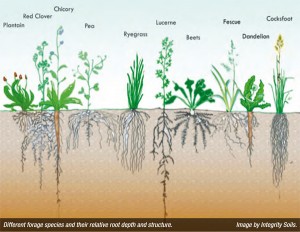
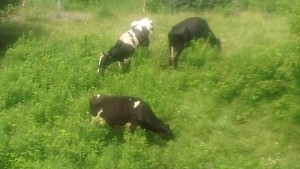
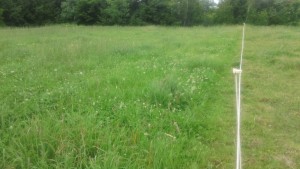
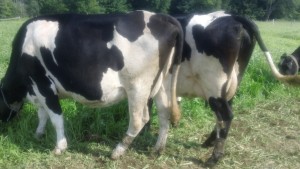
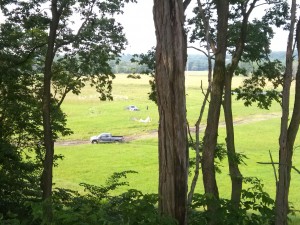
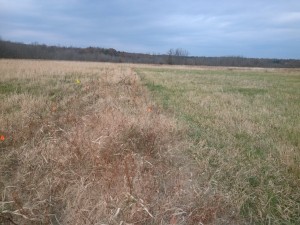
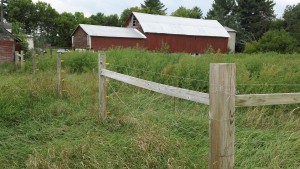

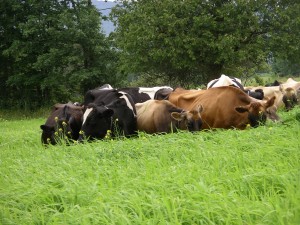
Recent Comments